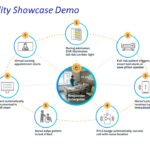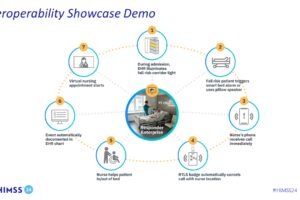The following is a guest article by Archie Mayani, Chief Product Officer at GHX
Artificial Intelligence (AI) has been a game-changer in various industries, but its integration into healthcare has been a more gradual process. While healthcare has undoubtedly made strides in harnessing AI’s potential, there’s still ample room for growth and development.
The pandemic accelerated the healthcare industry’s adoption of technology. One of the most notable changes has been the shift toward remote patient care, made possible by the increasing adoption of cloud-based solutions. The migration to the cloud has paved the way for implementing machine learning (ML), AI, and generative AI (GAI).
AI has the potential to revolutionize the healthcare industry. By harnessing the power of AI-driven technologies, healthcare providers can analyze vast volumes of patient data and gain valuable insights. This helps improve patient outcomes while reducing the associated costs of care delivery. When properly implemented, AI has the capability to automate repetitive and mundane tasks, allowing healthcare professionals to focus on more valuable work. For instance, AI models can help predict the impact of natural disasters or geopolitical events on the global supply chain, enabling providers to proactively mitigate potential product shortages. This approach enhances the overall resilience of healthcare organizations’ supply chains.
If your healthcare organization is considering or planning to leverage AI, it’s essential to approach this transformation thoughtfully and strategically. Let’s explore five essential steps to help successfully embark on the journey to AI adoption.
Step 1: Define Clear Objectives
Before diving into the world of AI, it’s vital to define your organization’s objectives and identify the specific problems you aim to address. Consider what challenges AI can help solve and how it can improve patient care, streamline processes, or augment decision-making. Whether the aim is to improve diagnostics, enhance operational efficiency, or personalize patient treatments, setting clear goals will serve as a guiding force in your AI adoption strategy. For instance, AI models might be used by a payor seeking to predict high-risk interventions or a provider launching a prevention program to improve outcomes.
Step 2: Build a Robust Data Infrastructure
Data is fundamental to ML or GAI development. To harness the power of AI, organizations must invest in a robust data infrastructure. This includes not only data collection but also data storage, processing, and security. In fact, the Healthcare Information and Management Systems Society (HIMSS) found that 67% of healthcare organizations have experienced a significant security incident in the past 12 months. A robust data infrastructure is vital to protect patient data, which is increasingly being targeted by cyberattacks. It’s also important to gather data from diverse sources, including electronic health records and medical imaging, ensuring data is reliable, routinely maintained, and easily accessible. Furthermore, establish data governance protocols to maintain privacy and compliance with healthcare regulations.
Step 3: Collaborate and Assemble the Right Talent
The successful adoption of AI in healthcare necessitates a comprehensive and interdisciplinary approach that involves collaborating with clinicians, data scientists, software engineers, and domain experts. To fully realize AI’s potential, building a cross-functional team capable of seamless cooperation and leveraging their diverse expertise is crucial. Additionally, investing in training and upskilling your existing workforce is paramount to ensure effective collaboration with AI systems and accurate interpretation of the insights they generate.
Step 4: Select the Right AI Technologies
The AI landscape in healthcare is vast and ever-changing. When selecting the most suitable AI solutions that best align with your objectives, it is crucial to consider various factors. These may include utilizing machine learning algorithms for predictive analytics, leveraging natural language processing to extract valuable insights from medical records, or incorporating computer vision to interpret medical images. Remember that interoperability and scalability should be central to your technology choices, enabling seamless integration into existing systems.
Step 5: Create a Culture of Experimentation
Before fully integrating AI into your healthcare processes, consider initiating small-scale pilots or proof-of-concept projects. This strategic approach will help identify potential challenges, fine-tune AI models, and ensure alignment with initial objectives. Be prepared to iterate and refine your approach based on feedback and results. Remember, AI adoption is a continuous journey, and achieving desired outcomes relies on continuous improvement.
AI has the potential to transform the healthcare industry by providing insights that can help healthcare providers deliver better patient outcomes while also reducing the costs associated with providing care. However, it’s essential to approach the adoption of AI thoughtfully and strategically. This entails defining a clear objective, building a robust and reliable data infrastructure, assembling a skilled interdisciplinary team, carefully selecting appropriate AI technologies, and continuously evaluating and enhancing the implemented solutions. By following these steps, healthcare organizations can harness the full potential of AI models to improve patient outcomes, optimize resource utilization, and foster innovation.
 About Archie Mayani
About Archie Mayani
As Chief Product Officer (CPO) at GHX, Archie Mayani drives the design and development of a contemporary, intelligent, and resilient healthcare supply chain management platform and solutions with a dedicated product development team. She has graced healthcare conferences, podcasts, and thought leadership forums as a speaker, spearheading discussions on cutting-edge ML/AI innovations. Her contributions extend to shaping healthcare products, influencing local and state-level healthcare policies, and impacting the healthcare industry through technology-driven improvements in human health and well-being.













